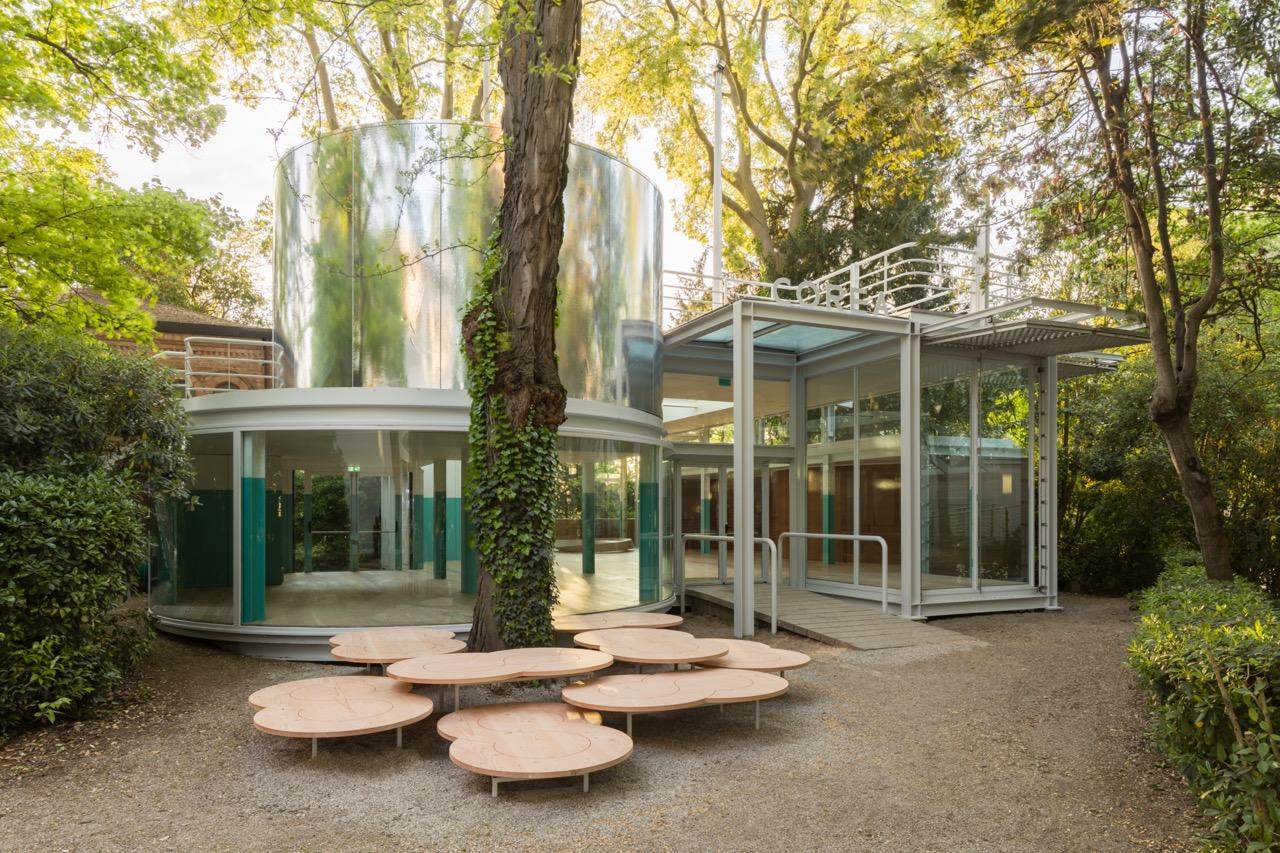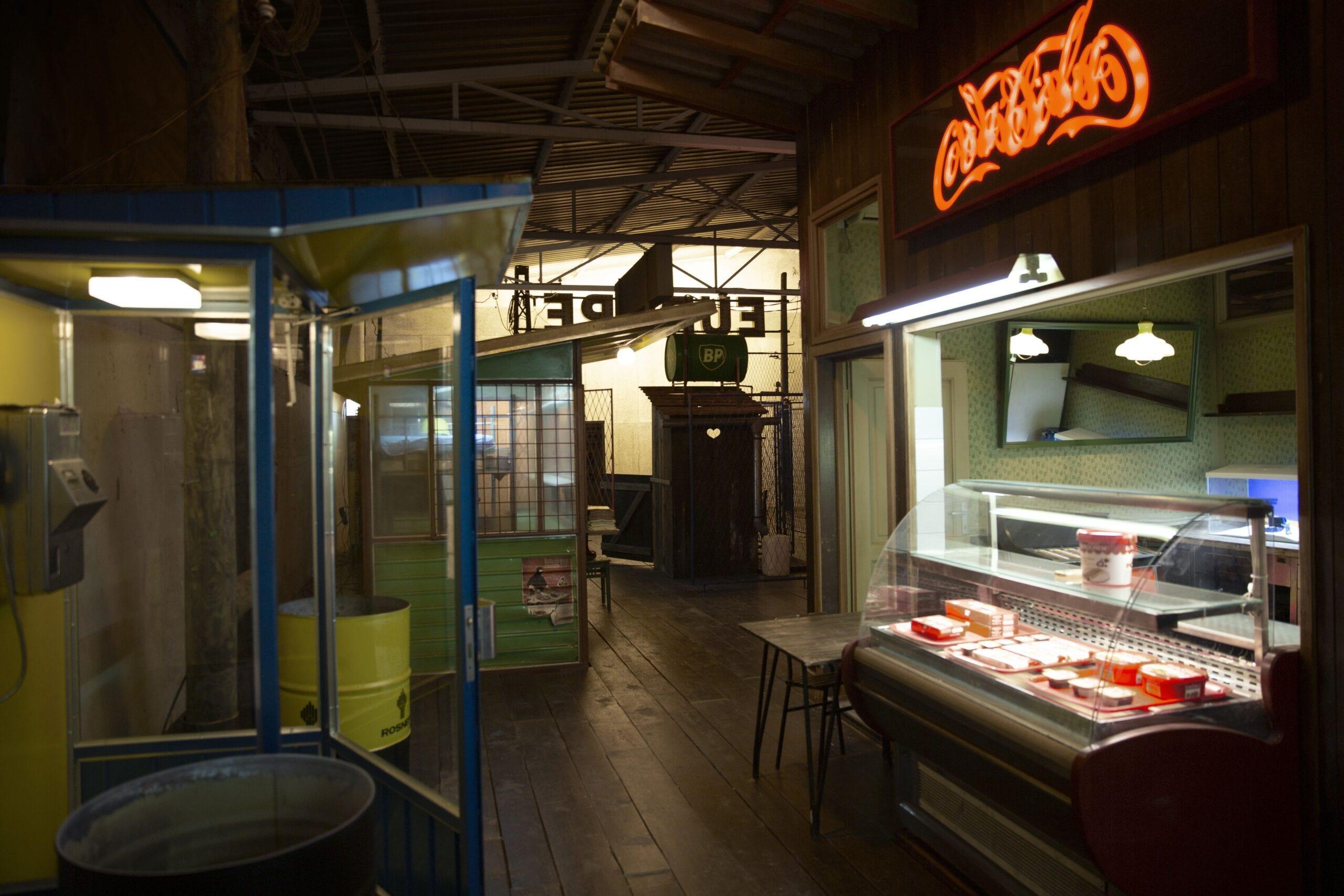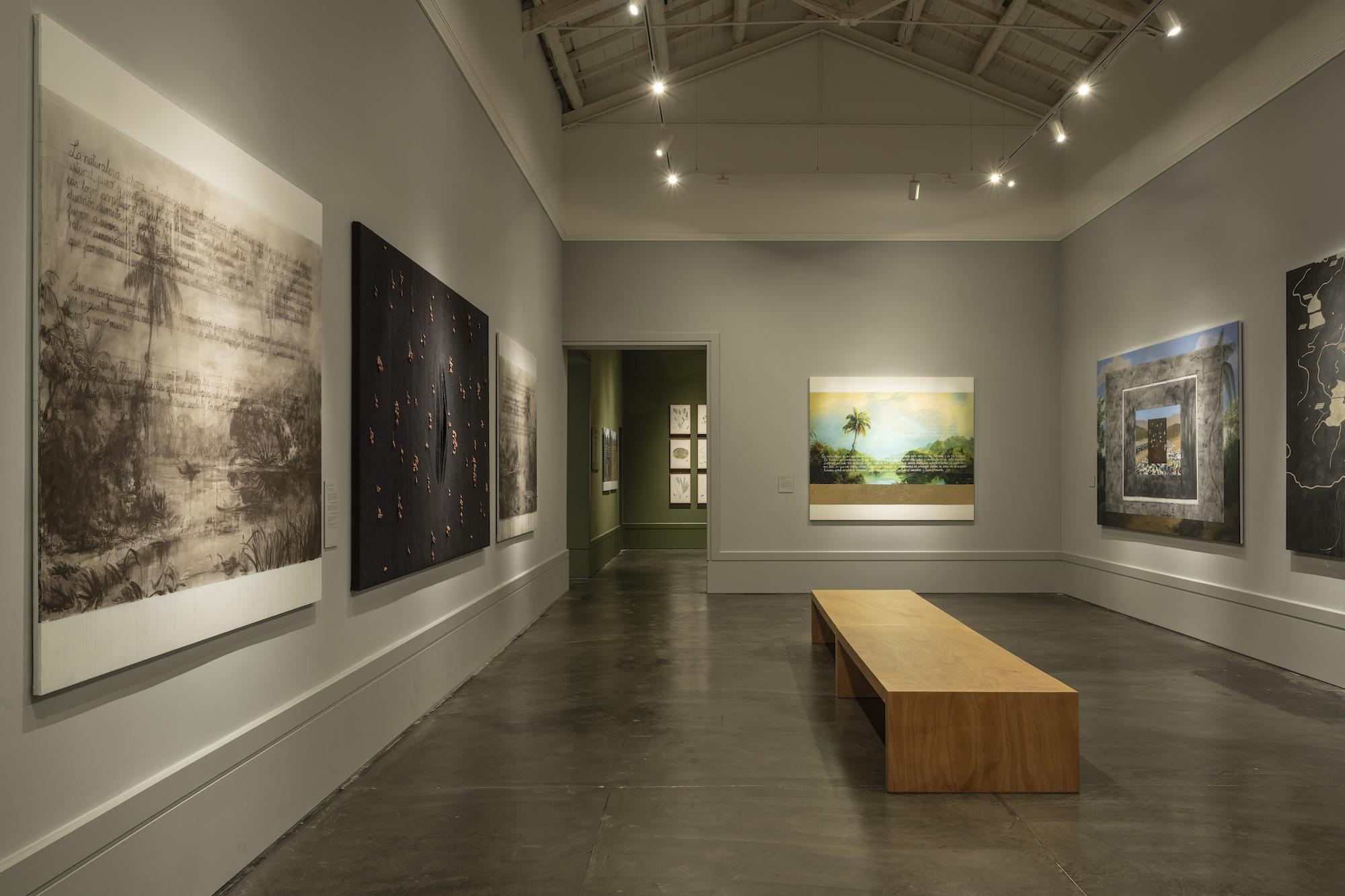
The Korean Pavilion / KOO JEONG A – ODORAMA CITIES, Korean Pavilion 2024, La Biennale di Venezia, Installation view, Courtesy of Pilar Corrias, London, and PKM Gallery, Seoul, Photo Mark Blower.
In an article series published on Frame’s blog, invigilators of the Finnish Pavilion in the Venice Biennale write about various topics related to this year’s Biennale. Maaria Mustakallio writes about how the Serbian, Korean and Spanish pavilions approach and utilise the exhibition space in presenting art?
Spaces where art is exhibited can be seen as fixed entities. Artists and curators take the spatial limitations of a gallery, museum or other exhibition space into consideration in various ways when planning an exhibition. Venice Art Biennale, alternating biannually with the Architectural Biennale, is a rich collection of exhibition spaces either modified or designed to house contemporary art. In this blog post, I will take a look at three national pavilions at the Venice Art Biennale 2024: Serbia, South Korea, and Spain, all located at the Giardini venue. I will consider how the art settles into the space, how it transforms, and transfers it. And in what ways does the space function as a transportational device in experiencing and ‘feeling’ the space through art?
Picture of a strange reality
Serbia’s exhibition at the 60th Venice Art Biennale, Exhibition Coloniale, is exhibited by Alexander Denić and curated by Ksenija Samadržija. Serbia’s contribution is not an art exhibition in the traditional sense: Denić has worked in the theatre and film industry, and his experience with stage sets can be seen in the exhibition.
Visitors enter the exhibition under the pavilion’s Jugoslavia –sign, passing an often unoccupied guard booth. The space is dark, the air thick and stuffy, and the outside heat slips in with the visitors. On the right the space opens to a fenced area with a big EUROPE -sign facing away from the rest of the exhibition. The visitor entering from the side is already in a space defined by the sign. The dilapidation, crackling neon of the signs, and cold halogen light hint at a question of whether the visitor is already in Europe, or in a failed promise of it. Time stands still. Different eras and decades exist simultaneously. According to the exhibition brochure, Denić deliberately employs Bertolt Brecht’s distancing effect “to create a picture of reality”. The space is loud. Uneven wooden flooring, creaking under every step, and a continuous loop of western pop music fills the dark, empty space above the visitor. In a room at the back of the exhibition, a TV is on, playing a 1970s Coca-Cola ad. “I’d like to teach the world to sing in perfect harmony” loops ad nauseam, and follows me, as I’m typing these words.
In many rooms, the artist has placed a mirror on the wall. While it might feel like you are visiting someone else’s dream or history, the mirror cracks the illusion by placing you firmly in the constructed reality of the exhibition space.The pavilion itself, designed by the Italian architect Brenno del Guidice in the 1930s, and bearing the sign Jugoslavia on its façade, speaks of the fractured nature of the space. The exhibition brochure describes the exhibition as a “spatial experience”. When you enter the space, it envelops you. At the same time, you remain a visitor, a stranger in the space. The “social memorabilia” of the exhibition – such as easily recognizable brands, rooms, and unfinished stories – act as a reminder of the cultural colonialism experienced by many. Stepping out of the exhibition, the overcrowded nostalgia of the space lingers in my body. As there are no introductory texts, what the visitor is left with, is the Brechtian effect of having experienced something that was real and not quite real, a picture of strange reality. This is the feeling the visitor carries outside the exhibition into the heat of Venetian summer.

Installation view. Aleksandar Denić: Exposition Coloniale, Serbian Pavilion, 60th International Art Exhibition, La Biennale di Venezia, 2024. Credits Aleksandar Denić, courtesy of the artist.
Space that leaves with you
When entering the Korean pavilion, a distinctive scent lingers in the space. I visited the pavilion a few times, and after the first visit, my brain connected the scent with the pavilion. On my second visit, I was able to bodily recognize the space as familiar. Otherwise, the space is bare. For the exhibition, the artist has requested a new hardwood floor to be put in, and carvings of overlapping eternity symbols are scattered on the floor throughout the space. Opposite the entrance a large wooden sculpture lays on the floor. To the left of the entrance is a small room with a levitating bronze sculpture depicting a humanlike figure, emanating a hint of perfume. The artist of the pavilion is KOO JEONG A, and the curators Seolhui Lee and Jacob Fabricius. KOO’s work, ODORAMA CITIES, is a collection of memories of Korea, collected via open call, and condensed into 16 fragrances that fill the Korean pavilion. The scents include keywords such as city smell, night air, the smell of Seoul, the smell of people, the salty smell, and the smell of the tree, among others. In their work, KOO is aware of the relationship between their artwork, and the space it occupies. In ODORAMA CITIES, KOO has attempted to transform the Korean pavilion into a space for a ‘Korean scent journey’.
Because of the bareness of the space, the spatiality of the exhibition is inevitably connected to the pavilion’s architecture. Built in 1995 and designed by Seok Chul Kim and Franco Mancuso, the pavilion has glass walls that enhance the bareness of KOO’s exhibition. The wooden flooring and extensions outside at the front of the pavilion make a slight shift in the pavilion’s spatiality, but the transformation, and transportation, of the space happens mainly through the experience of smell. KOO is interested in how people recollect and experience spaces through smell. Visitors carry the scents of the pavilion – and of the collected memories – with them as they exit; at the same time people bring their own personal scents into the space, mingling with the fragrances exhibited. This I noticed when walking near the pavilion, but metres away from it – I could smell the pavilion’s scent carried by recent visitors walking past me. The fragrance sticks: to your clothing, and in your mind. Through the fragrance also the space leaves with you, and so do the memories of the people who answered KOO’s open call.

Installation image of the Spanish Pavilion at the 60th International Art Exhibition La Biennale di Venezia. Photo: Oak Taylor Smith
Museum of historically silenced narratives
The artist Sandra Gamarra Heshiki and curator Agustin Perez Rubio at the Spanish pavilion have approached the pavilion space in a different way. Instead of building a space within a space as Denić, or emptying the space and filling it with scent, as KOO, Heshiki has used the gallery space as it was originally intended. What subverts the spatial experience is the content of the exhibition. Organised like a traditional, western museum space, the exhibition leads the visitor through numbered rooms with different themes. Migrant Art Gallery – Pinacoteca Migranta exhibits the history of Western colonialism and historical appropriation, shedding light on the problematic history of educational museum structures. Peruvian-Spanish artist Heshiki is the first immigrant chosen to represent Spain at the Venice Art Biennale. Migrant Art Gallery shifts the perspective of the Eurocentric museum structure to the historically silenced narratives, oftentimes exhibited as anthropological objects in the traditional, and colonial, museum spaces.
For a visitor accustomed to the western museum tradition, the space at first glance feels familiar, maybe safe, maybe even boring. The pavilion, designed originally by Francisco Javier de Luque in the early 1920s, and restored by Joaquín Vaquero Palacios in 1952, is a large space with an interior garden. On my second visit to the space, many other biennale visitors seemed to hurry through the color-filled rooms, only glancing at the thematically organised pictures and glass casings on their way. The names, and the themes, of the rooms – I. VIRGIN LAND, II. CABINET OF EXTINCTION, III. MISCEGENATION MASKS, IV. CABINET OF ENLIGHTENED RACISM, V. DYING LIFE ALTARPIECE, and VI. MIGRANT GARDEN – speak of the content of the exhibition. The first five rooms are organised as classical painting exhibitions. The spaces have seating in the middle of the room, the paintings are displayed with a certain spacing, and have information plaques next to them. Most of the paintings have long texts, both in English and Spanish, painted on them. The texts and paintings depict the violence inflicted by colonisers on indigenous peoples and the nature of the colonised lands. The paintings and the texts demand the visitor to stop and stay, and to witness the histories excluded in the western museum tradition. The last room, ‘Migrant Garden’ is a garden-like space with natural light, books, seating, and statues of different bodies. It is built as an invitation to imagine a different kind of space, and, as the curator Perez Rubio describes it in the brochure, as a counternarrative to the museum.
Because of the familiarity of the spatial structure of the exhibition, the content of the exhibition has a strong, visceral impact. The familiarity mixes with the unexpected and raises the question if what we are used to is how it is supposed to be. This is how the space reaches beyond its structural limits, and exhibits a vision of a more inclusive history, carried outside the pavilion and hopefully into the future.
Strangers in spaces
All three artists approach the exhibition space in different ways: Denić has condensed multiple spaces into the limited space of the pavilion, successfully fading the original room into the background and bringing forth an emotion-evoking theatrical ‘black box’ of cultural colonialism. The visitor is transported to a collection of unattached memories belonging to no one and everyone. A similar kind of play with memories and space can be felt in KOO’s use of scent and the bareness of the space. Smell is one of the strongest storages of memory, especially physical ones, and through scent, the space of the pavilion, and the memories of Korea, reach beyond the pavilion. Heshiki reconstructs the western, colonial museum space by using the spatial experience of the classic museum structure and shifting it to reveal the narrow perspective of the Eurocentric museum tradition. Through this subtle spatial shift, also the understanding of history and memory shifts, and carries outside the pavilion.
All three exhibitions experiment with how to fit into the allocated space and speak of the endeavour to move beyond it by evoking memories, feelings, and old as well as new attachments. Strangeness becomes familiar, and what is familiar becomes strange. The exhibition spaces move with the visitor, a stranger, beyond the limits of their physical boundaries.
– Maaria Mustakallio
Student; Exhibition invigilator, Pavilion of Finland
This blog is a platform for reflecting work, current issues and discussions in arts by Frame staff members and other contributors. This blog post is published in English.
